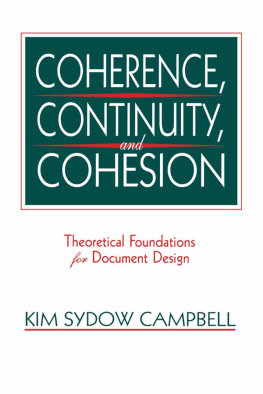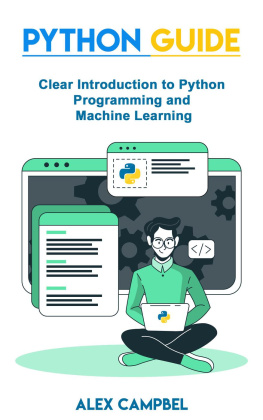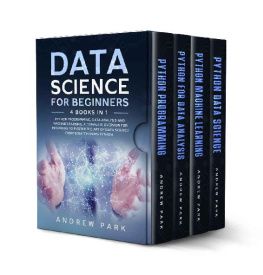Campbell - Python for Beginners: Comprehensive Guide to the Basics of Programming, Machine Learning, Data Science and Analysis with Python.
Here you can read online Campbell - Python for Beginners: Comprehensive Guide to the Basics of Programming, Machine Learning, Data Science and Analysis with Python. full text of the book (entire story) in english for free. Download pdf and epub, get meaning, cover and reviews about this ebook. year: 2021, genre: Home and family. Description of the work, (preface) as well as reviews are available. Best literature library LitArk.com created for fans of good reading and offers a wide selection of genres:
Romance novel
Science fiction
Adventure
Detective
Science
History
Home and family
Prose
Art
Politics
Computer
Non-fiction
Religion
Business
Children
Humor
Choose a favorite category and find really read worthwhile books. Enjoy immersion in the world of imagination, feel the emotions of the characters or learn something new for yourself, make an fascinating discovery.

- Book:Python for Beginners: Comprehensive Guide to the Basics of Programming, Machine Learning, Data Science and Analysis with Python.
- Author:
- Genre:
- Year:2021
- Rating:3 / 5
- Favourites:Add to favourites
- Your mark:
- 60
- 1
- 2
- 3
- 4
- 5
Python for Beginners: Comprehensive Guide to the Basics of Programming, Machine Learning, Data Science and Analysis with Python.: summary, description and annotation
We offer to read an annotation, description, summary or preface (depends on what the author of the book "Python for Beginners: Comprehensive Guide to the Basics of Programming, Machine Learning, Data Science and Analysis with Python." wrote himself). If you haven't found the necessary information about the book — write in the comments, we will try to find it.
Python for Beginners: Comprehensive Guide to the Basics of Programming, Machine Learning, Data Science and Analysis with Python. — read online for free the complete book (whole text) full work
Below is the text of the book, divided by pages. System saving the place of the last page read, allows you to conveniently read the book "Python for Beginners: Comprehensive Guide to the Basics of Programming, Machine Learning, Data Science and Analysis with Python." online for free, without having to search again every time where you left off. Put a bookmark, and you can go to the page where you finished reading at any time.
Font size:
Interval:
Bookmark:
Python for Beginners
Comprehensive Guide to the Basics of Programming, Machine Learning, Data Science and Analysis with Python.
Alex Campbell
Copyright 2021 by Alex Campbell - All rights reserved.
The contents of this book may not be reproduced, duplicated, or transmitted without direct written permission from the author.
Under no circumstances will any legal responsibility or blame be held against the publisher for any reparation, damages, or monetary loss due to the information herein, either directly or indirectly.
Legal Notice:
You cannot amend, distribute, sell, use, quote, or paraphrase any part of the content within this book without the consent of the author.
Disclaimer Notice:
Please note the information contained within this document is for educational and entertainment purposes only. No warranties of any kind are expressed or implied. Readers acknowledge that the author is not engaging in the rendering of legal, financial, medical, or professional advice. Please consult a licensed professional before attempting any techniques outlined in this book.
By reading this document, the reader agrees that under no circumstances are the author responsible for any losses, direct or indirect, which are incurred as a result of the use of the information contained within this document, including, but not limited to, errors, omissions, or inaccuracies.
Table of Contents
Python for Beginners
BOOK 1- Python Computer Programming: Simple Step-By-Step Introduction to the Python Object-Oriented Programming. Quick Start Guide for Beginners.
BOOK 2 - Python Machine Learning: Complete and Clear Introduction to the Basics of Machine Learning with Python. Comprehensive Guide to Data Science and Analytics.
BOOK 3 - Python Data Analysis: Comprehensive Guide to Data Science, Analytics and Metrics with Python.
BOOK 4 - Python for Data Science: Comprehensive Guide to Data Science with Python.
Python Computer Programming
Simple Step-By-Step Introduction to the Python Object-Oriented Programming. Quick Start Guide for Beginners.
Alex Campbell
Python is one of the most powerful computer programming languages of all time, for several reasons well discuss in the first section. The syntax is simple to learn and use and, compared to other programming languages, you often dont need to write so much code. The sheer simplicity of the language helps programmers write more and develop programs that are more complex in less time.
This guide provides all you need to master the basics of programming with Python. I have kept it deliberately simple it is a quick-start guide, after all. I have provided plenty of coding examples to show you how the syntax works, too, along with a guide on installing Python on Windows, Mac, and Linux systems. I finish with some useful tips on helping you to code better.
By the end of the guide, you will have a deeper understanding of the Python language, a stepping stone from which to take your learning further.
Please note that we are using Python 3 in this guide, not Python 2, as many similar guides do.
Are you ready to become a computer programmer? Lets get started on this wonderful journey.
Python is the brainchild of Guido Van Rossum and is a simple, all-purpose programming language. It is known for its easy syntax, easy-to-read code, and, for complete beginners to computer programming, it is one of the best to start with. Learning Python allows you to do many things, and there are several advantages to using it.
- Interpreted Language
That means an interpreter is used to parse any program you write, one line at a time. With compiled languages, such as the C languages, a compiler is used to compile the code before it is executed or run.
So, what is the difference?
Interpreted computer languages are a little slower than compiled languages and dont offer the performance benefits of compiled languages. However, the latter are too difficult and complicated for complete beginners to learn, and they require you to write every function, even the most basic ones. Advanced programming tasks sometimes require you to encapsulate data by creating data structures too. In a compiled language, therefore, all the small details must be taken care of before you can even begin to solve the problem the code is written for. With interpreted languages, you dont define data structures, and you dont define any of the smaller functions because Python does it all for you.
Plus, you can make use of the multitude of libraries included with Python without having to write reams of code.
- Dynamically Typed
Unlike compiled languages, with Python, there is no need to define the data type of a variable before you need it. Python can infer it automatically based on the value type in the variable.
For example:
myvar = "Good Morning Python."
In the above code line, we have a variable called myvar, and a string of Good Morning Python is assigned to it. That means myvar has a data type of a string.
Also, note that Python does not require a semicolon (;) at the end of a statement. Compiled languages do require this, and it is one of the most significant areas where errors occur forgetting to add semicolons can throw up all kinds of errors in the code.
Lets say that, a bit later, we wanted a value of 1 assigned to myvar:
myvar = 1
What does that do?
It makes the variable into an int (integer) type.
- Strongly Typed
If you have written any programs in JavaScript or PHP, you probably spotted that both will automatically convert the data in one data type into other types.
For example:
JavaScript
1 + "2"
Would be treated as 12.
1 gets converted into a string type and is concatenated (joined) to 2, thus the result of 12 that is a string. Python does not allow automatic conversions so the same code:
1 + 2.
Would result in an error like this:
Traceback (most recent call last):
File "main.py", line 2, in
1 + "2 "
- Less Code = More Achievement
Python uses far less code to achieve what other programs do; for example, it uses around one-third or one-fifth less code than Java.
You need only two lines of code to read Python files:
with open("myfile.txt") as f:
print(f.read())
For example:
# these lines create a "myfile.txt" file containing the data Lets Learn Python
with open("myfile.txt", "w") as f:
f.write("Lets Learn Python")
# Both lines will read the data from myfile.txt
with open("myfile.txt") as f:
print(f.read())
And the output would be:
Lets Learn Python
Dont worry too much about the commands used for reading and writing a file; I will cover it all as the book progresses.
Who Uses Python?
Many of the largest names use Python, such as NASA, Google. HortonWorks, Quora, and many others. Do you want to know what you can build with it? Just about anything, including:
- Web applications
- GUI applications
- Data scraping from a website
- Data analysis
- Developing games
- Building utilities for system administration
- And much more
Now you know what Python is and what you can use it for, well turn to setting up your environment and installing it on Windows, Mac, and Linux systems.
The first step is to download Python onto your Windows machine, so head to https://www.python.org/downloads and download the latest version for Windows. During the download, you will see a Customize Python window make sure the option to Add Python.exe to Path is checked.
Font size:
Interval:
Bookmark:
Similar books «Python for Beginners: Comprehensive Guide to the Basics of Programming, Machine Learning, Data Science and Analysis with Python.»
Look at similar books to Python for Beginners: Comprehensive Guide to the Basics of Programming, Machine Learning, Data Science and Analysis with Python.. We have selected literature similar in name and meaning in the hope of providing readers with more options to find new, interesting, not yet read works.
Discussion, reviews of the book Python for Beginners: Comprehensive Guide to the Basics of Programming, Machine Learning, Data Science and Analysis with Python. and just readers' own opinions. Leave your comments, write what you think about the work, its meaning or the main characters. Specify what exactly you liked and what you didn't like, and why you think so.








